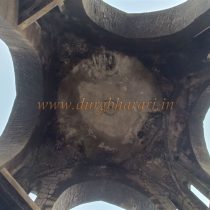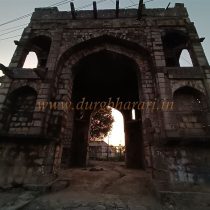TISGAON
TYPE : CITY FORT
DISTRICT : AHMEDNAGAR
Villages known as Tisgaon in Maharashtra are spread in various district. Each village has various reasons as to how the name originated or how the village came to be called Tisgaon. A similar reason is given for the origin of the name of Tisgaon, a village in Pathardi taluka of Ahmednagar district. This village once had thirty gates and the origin of the name of this village is said to be Tisgaon. But after visiting the actual village while walking around the village, it doesn't seem so real. Today there are actually five gates in this village and all these five gates are in the possession of the Archeology Department. All these five gates have iron fences and are maintained by the Archeology Department. So let's explore these gates. Tisgaon village in Ahmednagar district is 12 km from Pathardi taluka and 40 km from Ahmednagar. While traveling from Mumbai-Pune via Pathardi, Ves (gate) is easily visible on the main road in Tisgaon.
...
But the remaining four gates are scattered in different parts of the village. All these gates can be visited only after inquiring about them in the village. The gate seen from Ahmednagar-Pathardi Road is known as Ahmednagar Ves (gate). This very magnificent gate is about 40 feet high and there are grand arched doors on all four sides of the gate. This square-shaped gate is approximately 40 x 40 feet in size and has two floors in total. On the upper floor of the gate there are halls on all four sides. Even though these have been destroyed, the wooden beams under them can still be seen outside this hall. Looking at the overall structure of this gate, it is definitely not the gate of Nagarkot (city fort). Near this gate there is a medieval stone Shiv temple and behind this temple a well can be seen. This well is completely built in stone and there are steps on one side to get down into this well. After seeing this temple, go to see the next gate. The design of the two gates elsewhere in the village is not much different. One of these gates is near the Dagdhakhani Bagwan Masjid outside the village and the other is near the Pavan Hanuman temple in the central part of the village. The construction of all these three gates is identical. All these three gates do not appear to be related to the construction of the fort. Apart from this, the remaining two gates are through arches, one of which is near Vriddheshwar Vidyalaya (school) and the other arch is on the Tisgaon-Shirapur road. These arches are about 30 feet high. All the five gates have large wooden beams on the outside and some other structures attached to these gates. It takes about two hours to see these five gates properly if you have a car with you. Apart from this, we get to see the ancient Shiv temple in Tuljapur Peth in Tisgaon. The current name of this temple has been given as Mahadev Tuljabhavani Temple. There are many sculptures and some temple ruins lying in this temple area. From the pillars of the temple, it seems that the temple should be around the eighth century, i.e. Chalukya period. Looking at the Tisgaon Gate we can also see the ruins of Nagarkot (city fort) in Pathardi village nearby. Should there be Nagarkot around Tisgaon? This cannot be said with certainty as no remains of Nagarkot can be seen here. Tisgaon is a small but historic village in Pathardi taluka. Tisgaon was a market place during the Nizamshahi period. Since this village is on the road connecting to Paithan, this village has been important since ancient times. Salabat Khan of Nizamshahi lived in this village. Locals say that he built the present five gates in this village during the reign of Nizamshahi. Apart from this, locals say that his mansion (wada) and the entire village were surrounded by ramparts, but no remains of these ramparts can be seen today.
© Suresh Nimbalkar





















